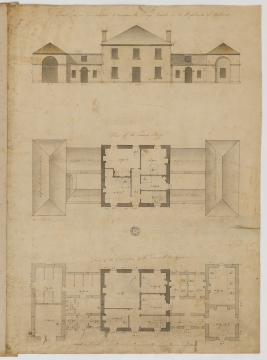Scale
scale: 10ft to 1inch
Inscribed
Inscribed in ink in a contemporary hand Front of an Inn adapted to answer the Kings Roads in the Highlands of Scotland; and with annotations naming elements of the building. The drawing is dimensioned.verso inscribed in ink in a contemporary hand Daniel Campbell of Shawfield Esq, and in a later hand 24 an Inn adapted for the Highland & Roads
Signed and dated
Medium and dimensions
Pen, grey and pale yellow washes499 x 365
Hand
Office of John Adam
Watermark
IHS and Villandry
Notes
In the opinion of A. A. Tait, this drawing relates in time and place or subject to those contained in Adam volume 7.As the inscription makes clear, this was a design for an inn connected with the Scottish Highlands road building schemes of General Wade before and after the Rebellion of 1745. At this time very rudimentary accommodation for both travellers and horses was offered: 'horses received as much attention as that provided for their riders' (see A.R.B. Haldane, New Ways through the Glens, Edinburgh, 1962, p.178). The drawing shows the central block in dark grey wash and the wings in light wash. This may mean that part of the structure already existed in some form and perhaps explains the word 'adapted' in the inscription. The inscription on the verso may refer to the notable anti-Jacobite Daniel Campbell of Shawfield, who died in 1753, or one of his sons. The draughtsmanship is similar to John Adam's drawings in the 1750s for Inveraray.
Level
Drawing
Digitisation of the Drawings Collection has been made possible through the generosity of the Leon Levy Foundation
Sir John Soane's collection includes some 30,000 architectural,
design and topographical drawings which is a very important resource for
scholars worldwide. His was the first architect’s collection to attempt to
preserve the best in design for the architectural profession in the future, and
it did so by assembling as exemplars surviving drawings by great Renaissance
masters and by the leading architects in Britain in the 17th and 18th centuries
and his near contemporaries such as Sir William Chambers, Robert Adam and
George Dance the Younger. These drawings sit side by side with 9,000 drawings
in Soane’s own hand or those of the pupils in his office, covering his early
work as a student, his time in Italy and the drawings produced in the course of
his architectural practice from 1780 until the 1830s.
Browse (via the vertical menu to the left) and search results for Drawings include a mixture of
Concise catalogue records – drawn from an outline list of the collection – and
fuller records where drawings have been catalogued in more detail (an ongoing
process).


